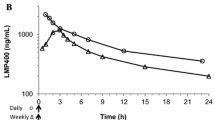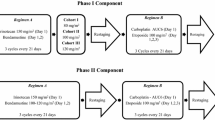Abstract.
Purpose: In vitro and in vivo preclinical models have demonstrated synergistic activity when topoisomerase I and II inhibitors are administered sequentially. Topoisomerase I inhibitors increase topoisomerase II levels and increase cell kill induced by topoisomerase II poisons. We evaluated this hypothesis in a cohort of patients with advanced non-small-cell lung cancer (NSCLC). Methods: A group of 19 patients with advanced NSCLC (70% adenocarcinoma) received topotecan at a dose of 0.85 mg/m2 per day as a continuous 72-h infusion from days 1 to 3. Etoposide was administered orally at a dose of 100 mg twice daily for 3 days on days 7–9 (schedule and dose derived from prior phase I trials). Total and lactone topotecan concentrations were measured at the end of the 72-h infusion. Blood samples were obtained immediately after each 72-h topotecan infusion in order to measure the mutational frequency at the hypoxanthine phosphoribosyl transferase (HPRT) locus in peripheral lymphocytes. Results: A total of 55 cycles were administered. Toxicity was mainly hematologic with grade 4 neutropenia occurring in 7% of courses. Only one partial response and two stable diseases were observed. The 1-year survival rate was 33%. There was a statistically significant difference between steady-state lactone concentrations between cycle 1 and cycle 2 with decreasing concentrations with cycle 2 (P=0.02). This was explained by a statistically significant increase in the clearance of topotecan lactone during cycle 2 (P=0.03). Total but not lactone concentrations correlated with nadir WBC, ANC and platelet levels. Steady-state plasma lactone levels correlated with the mutational frequency at the HPRT locus (P=0.06). In the one patient with a partial response a sixfold increase in HPRT mutational frequency was observed, which was not seen in patients with progressive disease. Conclusion: The combination of topotecan and etoposide in this schedule of administration has minimal activity in adenocarcinoma of the lung. This lack of activity may be due to the delay in administration of etoposide after the topotecan as studies have shown that the compensatory increase in topoisomerase II levels after treatment with topoisomerase I inhibitors is shortlived (<24 h). The HPRT mutational frequency results suggest that the lack of clinical response may be associated with failure to achieve sufficient cytotoxic dose as indicated by a lack of increase in mutational frequency in those patients with progressive disease. HPRT mutational frequency may correlate with plasma steady-state topotecan lactone levels. Future studies should be directed toward earlier administration of topoisomerase II inhibitors after topoisomerase I inhibition.
Similar content being viewed by others
Author information
Authors and Affiliations
Additional information
Electronic Publication
Rights and permissions
About this article
Cite this article
Dowlati, A., Levitan, N., Gordon, N.H. et al. Phase II and pharmacokinetic/pharmacodynamic trial of sequential topoisomerase I and II inhibition with topotecan and etoposide in advanced non-small-cell lung cancer. Cancer Chemother Pharmacol 47, 141–148 (2001). https://doi.org/10.1007/s002800000211
Received:
Accepted:
Issue Date:
DOI: https://doi.org/10.1007/s002800000211




